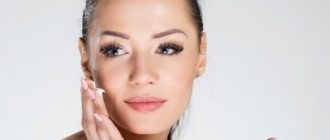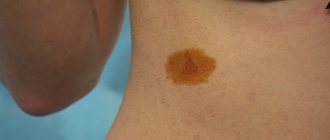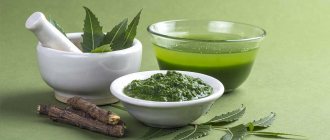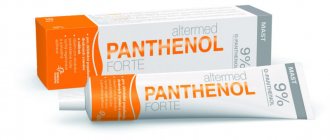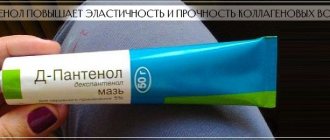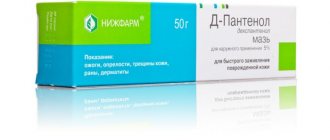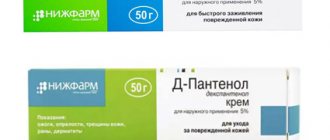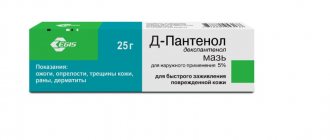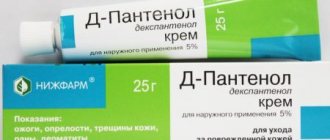345
230
Taking care of the health and protection of your baby's delicate skin requires special attention, because it performs many important functions. Therefore, your little one should have some helpers in her cosmetic bag. One of them is baby cream with panthenol. In what cases should it be used? And how often should I apply it to the skin? We deal with the most frequently asked questions about the use of panthenol.
Properties and composition of the drug
The pharmacological properties of the drug, produced in the form of creams, gels or sprays, are aimed at replenishing the deficiency of pantothenic acid that has arisen due to trauma to the skin.
Panthenol has the following properties:
- relieves inflammation and soothes the skin;
- regenerates and restores damaged epithelium;
- participates in oxygen and fat metabolism;
- normalizes the condition of nerve fibers and cellular metabolism.
The main active ingredient in the product is dexpanthenol, it is this that provides the ointment or gel with pronounced effectiveness, allowing newborns to use Panthenol for the treatment of many skin lesions, including diaper dermatitis.
In addition, medicinal ointments and creams based on dexpanthenol contain:
- analgesic allantoin (helps relieve redness, has an astringent effect);
- restorative vitamin E (corrects the activity of natural substances in the body’s metabolism).
All ingredients of the medicine are considered hypoallergenic and gentle, therefore they are allowed for newborn babies and older children.
Can Panthenol be used for newborns?
One of the main components of newborn care is baby skin care. According to statistics, children are more likely to suffer from skin diseases than adults. This phenomenon is due to the structural features of the epidermis and the imperfection of the immune system.
Features of infant skin
Parents have questions about child care almost from the first days of his life. In order to choose the right effective and safe products, you need to know the structural features and condition of the skin and mucous membranes of children.
In infants, skin makes up about 20% of body weight. The stratum corneum, which is the first line of the barrier mechanism, is very thin in a child, consisting of only a few layers of cells. Therefore, the epidermis is very susceptible to various damages.
If the care rules are not followed, it becomes injured, which increases the risk of various infections. The most common disease in infants is diaper dermatitis. Doctors attribute the increase in cases of this disease to the improper use of diapers.
The baby's epidermal cells contain large amounts of fluid. Violation of temperature and humidity leads to loss of water and is accompanied by drying out of the skin and its peeling. These symptoms are often mistaken for atopic dermatitis.
In addition, the skin layers have a weak connection with each other. The layer located between the upper epidermis and the lower, the dermis, is represented by the basement membrane, which in infants contains a low amount of collagen. Therefore, at the slightest damage, bubbles filled with liquid appear.
The tissues contain an increased amount of lipids compared to adults, which causes fat-soluble substances to penetrate into the deep layers of the dermis. The baby's skin is densely permeated with capillaries.
Some substances applied to its surface easily penetrate the thin stratum corneum and are absorbed not only into the depths, but also into the bloodstream, causing poisoning.
Therefore, when choosing skincare products, it is necessary to take into account their composition and strictly dose the amount.
Very strict requirements are imposed on hygiene products for children in the first months of life, especially for medications.
In babies, the sebaceous glands function intensively. They begin to work even before birth. The baby is born covered with a “lubricant” that protects its epidermis. The acid-base indicator of the secretion is close to neutral (pH = 6.3-6.7). The use of drugs that change the pH of the skin causes a “failure” in the functioning of the sebaceous glands, which provide antimicrobial protection.
Special requirements are imposed on the method of applying creams, ointments, gels, lotions - they cannot be applied directly from the tube and cover the entire surface of the body with them, since the respiratory function is carried out through the skin. This factor must be taken into account when choosing the form of the drug.
The listed structural features of the skin also determine the requirements for hygiene products. It has been established that improper treatment of diaper dermatitis can lead to serious long-term consequences - sleep disturbance, enuresis, and skin pathologies.
Indications for use of Panthenol
Panthenol, which has a composition as close as possible to the physiological one, is used to prevent:
- formation of abrasions;
- adiponecrosis (changes in the epidermis, compression, in the projection of skin folds, joints);
- maceration;
- diaper dermatitis;
- atopic dermatitis;
- chapping warnings;
- drying out and peeling from exposure to low temperatures;
- sunburn;
- eczema;
- infected wounds.
In addition, pantothenic acid salts have long attracted the attention of allergists and are used to treat allergic skin inflammation.
Panthenol has been successfully used by parents for a long time during hygiene procedures and in the treatment of skin pathologies. Its safety has been confirmed by numerous clinical studies.
Composition and mechanism of action
The active substance of Panthenol is dexpanthenol, a synthetic analogue of provitamin B5. Dexpanthenol is converted to pantothenic acid, which is involved in most reactions that provide the cell with energy. In its absence, the body cannot function normally.
Neonatologists recommend D-Panthenol cream and ointment as a therapeutic and prophylactic agent. The difference in their composition determines their different uses.
The composition of the ointment, in addition to dexpanthenol, includes:
- dehydrated “wool wax” – lanolin;
- white (cosmetic) Vaseline;
- Vaseline oil;
- purified water.
Cream D-Panthenol consists of:
- propylene glycol;
- dimethicone;
- glycerol derivatives.
The ointment is used if it is necessary to create a fatty barrier between the baby's skin and the liquid in the diaper area or to ensure slow penetration of substances. When using the ointment, dexpanthenol freely penetrates the epidermal layers and accumulates in the cells, providing long-term effects as a dermatoprotector.
The cream is easily absorbed, does not leave a greasy residue, and smells pleasant. It is used if there is no need to create a fat barrier, for example, for:
- the presence of infected wet areas near the application area;
- high natural fat content of the epidermis;
- poor absorption of lipids;
- individual reaction to the fat base in the form of irritation.
Clinical use of D-Panthenol in the group of premature infants, in whom the epidermis is most sensitive to damage, showed 100% effectiveness of the ointment in the treatment of atopic and diaper dermatitis, diaper rash, and abrasions. Adhering to the rules of application and taking into account the characteristics of the damage, within 2-3 days the following is noted:
- healing of affected areas;
- disappearance of redness;
- elimination of dryness, flaking;
- relief of itching.
If there are wet or infected areas on the surface of the body, then the ointment film can provoke the growth of pathogenic microorganisms, and the “greenhouse effect” will contribute to their penetration into the deepest epidermal layers.
When applying a cream or ointment when the first signs of skin pathologies appear, the effect is observed within a few hours. Panthenol can be used for a long time if there is no individual intolerance to the components.
But pediatricians advise not to use the drug if, as a result of its application, no visible improvement occurs within 3-5 days.
Why can you use Panthenol?
Panthenol meets all the requirements for therapeutic and care products for young children. Its advantages are that:
- contains no dyes, flavors, or preservatives;
- there are no organic components that can cause allergies;
- pH is close to neutral;
- contains no antibiotics or hormones;
- efficiency is 100%;
- no side effects;
- can be used for a long time;
- even when applied to a large area of the body there is no systemic effect;
- easy to use;
- application does not cause discomfort - a feeling of stickiness, unpleasant odor, burning;
- can be used both as a therapeutic and prophylactic agent;
- has a wide range of indications;
- affordable and available without a prescription.
The drug does not contain toxic, oncogenic, allergenic or other substances potentially dangerous to the child’s body.
Panthenol has the following medicinal properties:
- dermatoprotective;
- anti-inflammatory;
- regenerating.
It is these therapeutic effects that are necessary to maintain the health of children's skin. The use of D-Panthenol is allowed even for the prophylactic purpose of damage to the epidermis in premature, weakened children in incubators.
Clinical studies conducted in pediatric departments of domestic clinics have proven the complete safety and absolute effectiveness of using Panthenol in newborns and children in the first months of life. Neonatologists, pediatricians and dermatologists recommend replenishing your home medicine cabinet with Panthenol preparations.
Source: https://flory-spray.com.ua/articles/mozhno_li_ispolzovat_pantenol_dlya_novorozhdennykh/
Indications for use
Pediatricians prescribe panthenol to children from the first days of life , so this local drug is classified as a medicine based on B vitamins, and it is an environmentally friendly and safe product.
For newborns, Panthenol is used in case of a number of skin problems:
- When severe dryness of the baby’s skin appears, comprehensive moisturizing and softening of the epithelium at the cellular level is required. Considering the age of a small patient, it can be difficult to find a safe medicine for him, so Panthenol will come to the rescue.
- Diaper rash, in the absence of comprehensive and serious treatment, can develop into contact and diaper forms of dermatitis, prickly heat, which are treated with this anti-inflammatory local remedy.
- Scratches and abrasions received accidentally during childbirth or the first bath can be treated with Panthenol, stimulating the healing and restoration of damaged delicate skin.
More serious problems in infants caused by viral infections, such as herpes zoster, consequences of thermal effects, are also treated by applying Panthenol in combination with other drugs.
Features of therapy
Treatment methods and doses for young patients depend on the pathology, its etiology, and the severity of epithelial damage.
- Skin lesions that progress against the background of increased dryness of the epithelium are treated with ointment, since this dosage form is less greasy and promotes high-quality hydration of the skin.
- Irritations in a child caused by exposure to moisture - diaper rash, prickly heat - are removed with the cream variety of Panthenol, since the cream dries out the epithelium, removing excess moisture.
- The dosage form in the form of a spray can also be used to treat injuries in newborn babies, using it for both dry and overly wet skin.
Pediatricians recommend applying the drug to the child after each diaper or romper change. As a rule, wound treatment should be carried out no more than 4 times a day, the medicine should be applied in a thin layer.
Panthenol for babies
Often mothers repeat the same mistake - they wrap the baby too much, which is why it overheats. As a result, the child develops a small, bright pink rash.
And wearing a diaper for a long time threatens the formation of diaper rash. According to statistics, more than 90% of newborns suffer from such skin problems.
Therefore, parents are looking for safe and effective means to restore the baby’s delicate skin.
D-Panthenol is a series of popular drugs that are used for various injuries (scratches, wounds, burns, abrasions) and diaper rash. The drug relieves inflammation, stimulates tissue regeneration (skin, mucous membranes), improves cellular nutrition and skin condition. The drug is used to treat patients of different age categories.
Diaper rash in children
The skin of newborns is vulnerable to environmental influences, and therefore they are more likely to suffer from diaper rash or rash. The main causes of inflammatory processes on the skin:
- Failure to comply with infant care rules.
- Violation of child hygiene.
- Use of diapers of dubious quality.
- Staying in a dirty diaper, rompers or diaper for a long time.
- Contact with skin by feces or urine.
Before using special products, it is better to consult a dermatologist. The doctor will assess the extent of the damage and select the appropriate medication. You should not choose the drug yourself, as the product can cause allergies. The problem should not be ignored, as diaper rash soon turns into eczema.
D-Panthenol: description of dosage forms
Panthenol for diaper rash is produced in the form of ointment, cream, spray. The main component of all pharmaceutical forms is dexpanthenol; they differ only in additional components:
- lanolin;
- phenonip;
- beeswax;
- soft white paraffin;
- emulsifier;
- food additive E1520;
- distilled water, etc.
- cetearyl octaonate;
- ketomacrogol;
- preservative E218;
- cetanol;
- propylene glycol;
- dimethicone;
- glycerol monostearate, etc.
- wax;
- mineral oil;
- peracetic acid;
- isobutane;
- propane.
The drug in the form of a cream and ointment is in an aluminum tube, and Panthenol spray is in a bottle with a sprayer on the neck.
Panthenol improves tissue regeneration abilities. After penetration into the skin, dexpanthenol is metabolized to pantothenic acid (calcium pantothenate), replenishing its deficiency. When the integrity of the skin is compromised, the deficiency in calcium pantothenate increases; this substance helps restore cellular metabolism and strengthen collagen fibers.
D-Panthenol is effective, the drug stimulates the regeneration of the epidermis and the restoration of mucous membranes by compensating for the lack of pantothenic acid. When applied externally, the drug is gradually and deeply absorbed into the skin. In addition, the medicine is good because it accelerates the healing of wounds and ulcers.
Application and dosage
The method of application and dose of the drug depend on the disease. For diaper rash, inflammatory lesions of the skin, mucous membranes, bedsores, use the drug 1 to 4 times a day, depending on the symptoms.
The choice of dosage form depends on the skin type. If the patient has dry skin, then ointment is prescribed, since it is more oily. This dosage form is used to treat cracks and moisturize dry skin. Cream is used to treat wet wounds and burns because it contains no fat.
Source: https://sustavo.ru/info/pantenol-dlja-mladencev/
Use with caution
A small child is allowed to use Panthenol from the first days of life. Despite the safety of the medicinal ointment, before systematic treatment, a sensitivity test and possible reaction to the drug should be performed.
- A small amount of ointment is applied to the baby’s skin and left for two to three hours, allowing it to be absorbed.
- After time has passed, the baby’s skin is checked: if redness or swelling does not appear at the site where Panthenol was applied, the medicinal ointment or cream can be used for therapeutic purposes.
The scheme and frequency of treatment depends on the severity of the lesion: for mild and mild redness, treat the baby’s skin 1-2 times a day. For progressive dermatitis and severe diaper rash, the drug is applied up to 4 times, often combined with other therapeutic effects.
The medicine is contraindicated
Pediatricians categorically do not recommend using Panthenol if the baby has contraindications for use.
- Panthenol is contraindicated in case of hypersensitivity to the components of the drug.
- Anti-inflammatory cream or ointment should not be applied to infected areas of the skin.
Panthenol can be given to newborns to treat skin irritations only after consultation with a pediatrician or neonatologist, since Panthenol is a drug and can cause side effects during use.
How to use
If the drug is used to treat infants, precautions must be taken. Apply panthenol carefully so as not to get on the mucous membranes. Apply to damaged skin with each new swaddling, about 5 times a day. As a rule, improvement occurs already on the second day after using D-Panthenol. To prevent diaper rash from making itself felt again, the cream is applied to clean skin as a preventive measure.
In this case, the places can be very different - the area of the buttocks and the inguinal folds. Apply to affected areas after every bath and change of underwear.
Panthenol is used not only in children. Mothers who have experienced symptoms of cracked nipples during breastfeeding know a little trick. In the first month after the birth of the child, they apply Panthenol to the chest and over time the unpleasant symptoms disappear. You should not treat nipples before breastfeeding, only after it.
The faster the better
It is best to treat diaper rash in a child at the first stage of the disease. Usually at this time small red spots appear on the skin. In this case, therapeutic measures will give maximum effect. The deterioration of the situation stops and diaper rash with its unpleasant symptoms no longer bothers the baby. You can use special baths and ensure good skin hygiene. If the skin is significantly damaged, you may need to take antibiotics.
Processing rules
The use of Panthenol for newborns must comply with a number of preventive and therapeutic rules.
The basic rules of the doctor are compliance with the following conditions:
- After removing a diaper or diaper, a newborn baby should definitely wash the skin with warm water, preferably with a soap solution;
- when the first symptoms of diaper rash appear, it is recommended to minimize the use of disposable diapers, carry out timely treatment with Panthenol and hygiene procedures;
- After hygienic washing, it is recommended to gently blot the baby’s skin with a soft towel, do not rub or injure the inflamed area;
- During the day, the baby should undergo repeated air procedures, providing air access to the inflamed skin;
- thoroughly rinse children's underwear and clothes from washing powder and detergents;
- Every day you should give your baby healing baths with the addition of decoctions of medicinal herbs or a solution of potassium permanganate.
Parents need to especially carefully monitor the hygiene of the baby: change his diapers in a timely manner, make sure that the child does not lie in wet and soiled diapers.
The mother should also be sure to monitor her diet if she is breastfeeding, since diaper rash is often caused by allergens entering the body. If the mother treats the nipples with this drug to prevent cracks and wounds, she can give the newborn Panthenol with milk. In this case, you should first make sure that there is no reaction to the active ingredients of the medicinal ointment.
Possible side effects
Usually, a negative response to the use of Panthenol or its analogues in newborn infants does not occur, but in some cases, when treating the skin with this drug, local reactions may be diagnosed in a child:
- redness and swelling in the area treated with Panthenol;
- pinpoint rash or bright rash;
- increased diaper rash and irritation during treatment.
If such reactions occur, experts recommend that you stop treating your newborn baby with Panthenol and consult a pediatrician.
